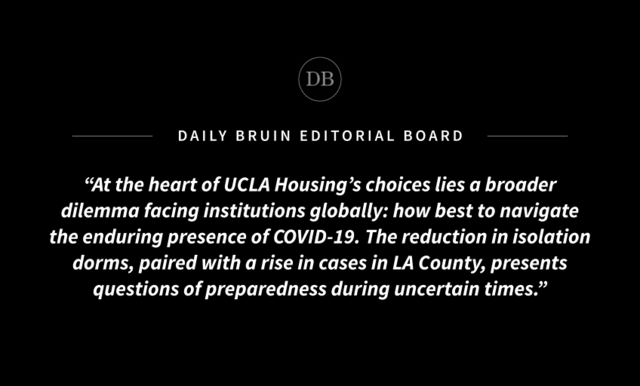As COVID-19 transitions from a daily concern to an endemic backdrop in the lives of Bruins, there’s danger in complacency.
For the 2023-2024 academic year, UCLA Housing has reduced the number of isolation dorms, causing concern among students regarding their safety.
The UCLA Infectious Diseases Management Team claimed this decision was influenced by low use last year, declining rates in COVID-19 cases and a pressing need to provide yearlong housing for students. While the university has addressed the community’s housing crisis with a four-year housing guarantee to undergraduates, Los Angeles County experienced a spike in COVID-19 cases as students began returning to Westwood.
At the heart of UCLA Housing’s choices lies a broader dilemma facing institutions globally: how best to navigate the enduring presence of COVID-19. The reduction in isolation dorms, paired with a rise in cases in LA County, presents questions of preparedness during uncertain times.
UCLA must maintain its consideration of the health and well-being of students who test positive, those who share living spaces with infected individuals, and the immunocompromised. Their needs and safety cannot be sidelined in efforts to pursue other objectives.
The challenge to find an isolation space is exceedingly difficult for off-campus students who don’t have access to the university’s isolation dorms if they get sick. Without access to private isolation quarters, they run the risk of infecting their roommates and furthering the spread of COVID-19.
Last year’s isolation protocol in the dorms wasn’t ideally efficient either, as students were still sometimes placed in shared isolation rooms, exacerbating already stressful situations and the social aspect of living with a stranger.
With COVID-19’s future still uncertain – especially given the spike of cases upon students’ return to campus – it’s worrying to hear UCLA may not have capacity to house students should the community witness an even larger rise.
According to an emailed statement from the UCLA Infectious Diseases Management Team, the reduction in isolation room capacity is based on past data. During the last winter and spring quarters, a maximum of 18 isolation spaces were used, even during fluctuating and peak times. The statement added that it is important to balance having isolation spaces while also accommodating undergraduate student housing needs.
The university continues to provide resources, including free PCR testing and protective masks.
However, while past data serves as a reference, the dynamic nature of the pandemic demands a more comprehensive approach. Just the potential of housing multiple infected students together in limited isolation spaces is enough of a reason to re-establish robust isolation capacity.
The Editorial Board supports the university in its efforts to provide more yearlong housing for students amid Westwood’s competitive housing market. But this work should not come at the expense of student’s health and safety.
The pandemic sparked critical conversations relating to accessibility, hybrid education and the pressures many face to work through illness to the forefront of public discourse.
More than three years removed from the beginning of the pandemic, policies and practices will inevitably need to change – but these conversations and challenges will remain with our community long after.
Fewer classes are being recorded, professors are becoming more strict about attendance or missing exams due to illness, and now, the university is providing fewer isolation dorms for students with COVID-19.
Even as we move toward a world in which COVID-19 functions more and more like the seasonal flu, the lessons learned from the pandemic – not to mention the precautions we’ve taken to get to this point – should not be forgotten so easily.


Comments are closed.